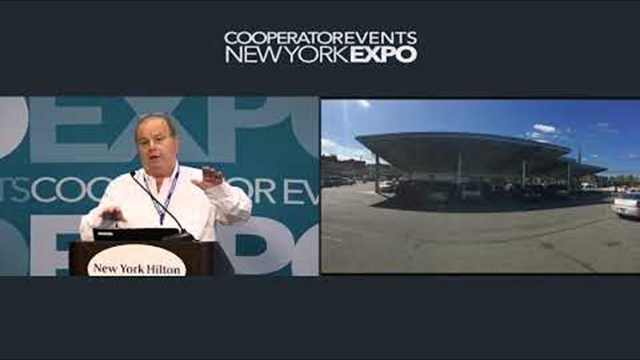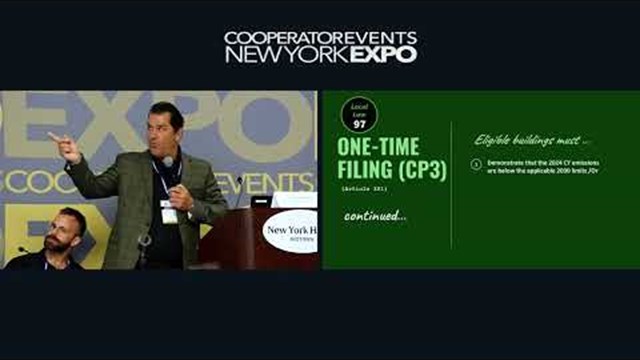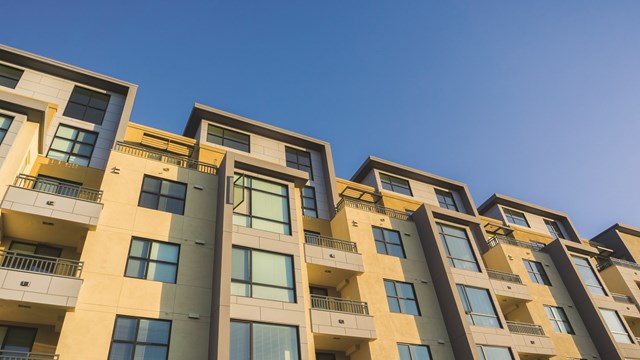This past spring, New York City took a huge step in confronting the threat of climate change with its own version of a ‘Green New Deal.’ On April 18, the City Council passed the Climate Mobilization Act, a package of bills aimed at getting the Big Apple to do its part in fighting global warming. The centerpiece of the legislation is the citywide requirement for buildings 25,000 square feet and larger to reduce their greenhouse gas emissions 40 percent by the year 2030, and 80 percent by 2050. Building owners and landlords who don’t comply with the new efficiency standards will be heavily fined. The emissions caps go into effect starting in 2024.
“Buildings that are 25,000 square feet or larger make up just two percent of the 1.1 million structures in New York City, yet account for 30 percent of our overall greenhouse gas emissions each year,” City Councilman Costa Constantinides (D-22), the sponsor of the legislation, tells The Cooperator. “We’ve seen clear science that says we’ve got to reduce our carbon output. The alternative – doing nothing – will let sea levels rise to a degree that puts JFK Airport underwater and turns tens of thousands of New Yorkers who live near our coast into refugees.”
Not everyone is welcoming the new emissions law – now known as Local Law 97 – with open arms, particularly condo and co-op owners who feel they are being singled out to shoulder the necessary upgrades to meet the emissions limits. In a statement, then-Real Estate Board of New York (REBNY) President John Banks said that the legislation “does not take a comprehensive, city-wide approach needed to solve this complex issue...The approach taken...will have a negative impact on our ability to attract and retain a broad range of industries, including technology, media, finance, and life sciences, that provide opportunity and continued economic growth that is so important for our city.”
Christopher Rizzo, an attorney with Carter Ledyard & Milburn who co-wrote an article about the Climate Mobilization Act for the New York Law Journal, describes the legislation as groundbreaking. “Buildings can reduce their carbon emissions by 40 pecent by 2030,” he explains. “But there needs to be a variety of compliance options and financing assistance. Only the rules will clarify whether the City will address those two issues.”
What Does Local Law 97 Do?
Affecting approximately 50,000 buildings in the city, Local Law 97 sets forth greenhouse gas emissions limits for the years 2024 to 2029 and 2030 to 2034. According to the nonprofit group Urban Green Council, “The building emissions law sets emissions intensity limits (metric tons of CO2e per square-foot) for 10 building categories based on Building Code occupancy groups.” For instance, buildings in the Occupancy Group R-2 category (which includes apartments) can only emit up to .00675 tons (or 6.75 kilograms) of carbon dioxide per square-foot in the year 2024. Then in 2030, the emissions limit shrinks to .00407 tons (or 4.07 kilograms) of carbon dioxide per square-foot. According to the statute, building owners whose properties exceed the emissions limit are subjected to “a civil penalty of not more than an amount equal to the difference between the building emissions limit for such year and the reported building emissions for such year, multiplied by $268.”
Local Law 97 also establishes the Office of Building Energy and Emissions Performance (OBEEP) within the city’s Department of Buildings to ensure that the measures under Local Law 97 are implemented. Meanwhile, houses of worship, city-owned and NYCHA buildings, low-income housing, and rent-regulated accommodations are exempted under the new law.
According to the law, starting on May 1, 2025 and every May 1 after that, building owners are required to file a report with the department, certified by a registered design professional, stating that either the building has complied with the emissions limit, or gone over it. Failure to submit a report will result in a fine of 50 cents per building square-foot per month.
The new law also creates a ‘property assessed clean energy’ (PACE) program that will help owners finance retrofitting projects through low- or no-interest loans. “Local Law 97 takes financial hardship into consideration as to whether one’s carbon number can be adjusted,” Constantinides explains. “The idea is you pay down your savings, so there’s no extra cost to the owner. If you save $10,000 per year from upgrading your lights, you would use those savings to pay back your loan. Once the lifetime of the loan is over, those savings are yours. Buildings that have already gone green should be commended, as we’ve seen some who already meet their 2024 and 2030 numbers thanks to their forward-thinking investments.”
Critics of the Legislation
Following its passage by the City Council this April, the legislation has generated criticism from the real estate industry. Opponents pointed out that market-rate co-ops and condos are being targeted while other properties are exempted. Among those critics is Stuart Saft, an attorney with New York-based law firm Holland & Knight and the president of the Council of New York Cooperatives & Condominiums (CNYC). “I am fully in agreement with the fact that we as a society have to do something about climate change,” he says. “We can’t ignore it, and we have to take care of it. But the bill that ultimately was enacted was just unfair.”
Saft’s own prewar co-op building on the Upper East Side spent $350,000 to switch from No. 6 heating oil to natural gas three years ago. He says he doesn’t see his building being able to meet the city’s emissions goal by 2030. “We basically would have to open up and re-insulate all the walls and change the heating system,” Saft explains, “which we can’t do because the expense would be in the tens of millions of dollars. Because we’re a landmarked building, we’re limited on what we could do that would affect the exterior appearance of the building.”
Saft especially takes issue with the penalties to be exacted if a building fails to meet the emissions caps, adding that he has elderly neighbors who live on fixed incomes and would be hit hard by additional expenses. “We’ve tried to control costs, but we’re gonna get hit over the head with an axe in 11 years,” he says. “It’s so unfair.”
Like Saft’s building, 2 Tudor City Place, a 300-unit co-op in Murray Hill, has already made efforts to go green, according to its managing agent and resident Timothy Grogan. He says his building has implemented a co-generation system, switched to LED lighting, and reduced the amount of energy used by its elevators when they’re not in operation. “[The new law] is putting a real impact on the budgets of co-ops and condominiums throughout the city,” Grogan says, “because these are things that they weren’t prepared for. So it’s putting a little bit of fiscal stress on the buildings.”
He doesn’t know how much his fellow owners will have to pay in increased maintenance charges as a result of the emissions law: To him, it comes town to statistics.“There are no...numbers that can show you ‘Hey, if you reduce your carbon footprint, you’re going to be saving X-many dollars on your utility costs.’ So that’s the difficult part. There’s also the insurance aspect of it, because now you’re taking on liabilities for the responsibility of doing certain things, and there are penalties that are involved that are really going to be steep and difficult to absorb. It’s fast and furious right now.”
As his building has utilized co-gen and changed over to gas, Grogan says there’s not much more that can be done, other than costly window replacement. “I don’t know what the payback period on changing windows is. We haven’t looked at that aspect yet, because that’s part of the whole retrofit process...These windows were put in 40 years ago. So what’s our return on investment? In a 300-unit building with an average of nine windows in an apartment, you’re looking at a hell of a lot of windows.”
Constantinides insists that the penalties are not intended to provide a revenue stream for the city. “I don’t want your money, I want your carbon,” he says. “This was designed in a way that the targets can actually be hit. The fines are there to make sure this bill has teeth, and that they’re not the cost of doing business. We also believe they equal the cost of upgrades, so not doing the retrofits and simply paying the fines means you have an ideological opposition to climate change.”
He also says the OBEEP will take into account buildings’ good faith efforts to meet the caps before issuing a penalty or adjusting a structure’s carbon emissions number. “If you’ve applied for PACE financing, a NYSERDA grant, or other means to fund this project but were denied, that’ll be considered by OBEEP. And if an owner has attempted retrofits but still hasn’t hit the number, that will be considered. OBEEP will factor all of these into consideration before deciding on a fine. We wanted to make sure that flexibility was there for those who have tried to make the upgrade but couldn’t because of things out of their control. “
Plan Now
Condo and co-op owners whose buildings are at risk of not meeting the emissions limits can start preparing to be compliant with the law. Sentient Buildings, a New York City building automation company, suggested the following:
*Conduct an audit to better understand your building’s energy usage
*Based on data from this audit, identify the most critical problem areas to focus on first
*Adopt a long-term plan to eliminate energy waste and increase efficiency
*Begin to execute your strategy, focusing on solutions that can lower operating costs in addition to reduce carbon emissions
“Most buildings in New York City of about 50,000 square feet have been conducting an annual benchmarking,” says Sentient Buildings president David Unger. “They’ve been performing annual benchmarking work where they’ve been submitting their utility bills to a portfolio manager and getting what’s called an energy usage index (EUI) of how well they’re doing.”
From a planning standpoint, Unger says the first step for building owners is to understand their building’s past energy usage, and then translate that energy usage into a carbon emissions index and compare that to what the requirements are going to be for the building, “Because the expectations are going to be set in 2024 that buildings are going to have to lower their emissions to a certain level.”
Unger adds that if a building is potentially at risk for exceeding the carbon emissions limit for 2024, its owners should review and understand what immediate measures can be taken that will get the building within the compliance standard. “That’s something that should be going on right now with every building owner,” he says, “looking at capital budgets that they may have available to do this work. They really need to start prioritizing those projects. The more data you have to understand the building performance, the more informed decisions you can make on what needs to happen.”
What’s Next...
As reported by The New York Times, Mark Chambers, the director of the Mayor’s Office of Sustainability, said that while the cumulative cost for building owners to make the retrofits would go over $4 billion, they would later recover that spent money in reduced operating expenses. But not everyone is convinced about the return of investment from the retrofits, let alone if the city will be able to meet the 40 percent carbon emissions reduction goal by 2030. “I was told the same thing when we were told we should convert from No. 6 oil to natural gas,” Saft says, “and as I said, it cost $350,000. Our heating costs went down slightly, but it’ll take decades to recover that cost. I don’t imagine that we’re going to have any kind of significant savings to make up for what the costs are going to be.”
Rizzo says that in the first few years of the law, the fines will be significant but manageable for most but not all buildings “Partial compliance with the law is possible to minimize the fines. But by 2030 the emission limits will drop sharply, and without very significant financing and technical assistance, the fines could become unmanageable for some buildings.”
In his view, Constantinides says that New York City is now at a crossroads: it can either continue its current energy infrastructure or find new and clean ways to generate energy without making its citizens sick from harmful toxins. “That being said, I also realize how difficult it has become to own a home in New York City. You shouldn’t have to be forced out of your home by rising costs – or rising sea levels. The intent of this law was not to punish co-ops and condos, but to reduce the massive amounts of carbon pumped out of a disproportionately small share of buildings.”
David Chiu is an associate editor at The Cooperator.










Leave a Comment